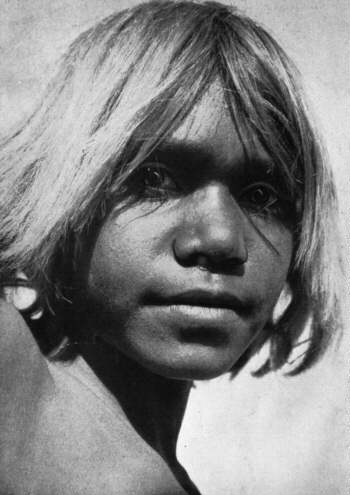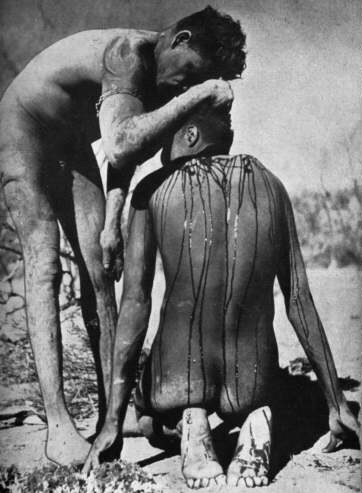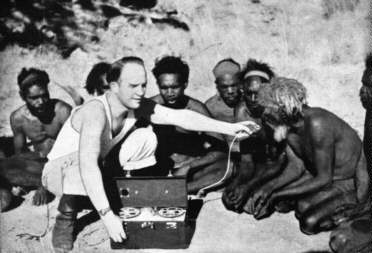
|
|
| Cannibal Culture | |
|
Selected excerpts from Jens Bjerre’s The Last Cannibals on primitive beliefs and customs Australia |
Bloody Ceremonies in the Desert: Native Love Life
Almost every night I used to sit for an hour with Jimmie, the interpreter, surrounded by the old men of the tribe. I tried to tell them, in simple metaphorical language, a little of the world beyond them, but I think they found it all beyond their range of imagination. They could not conceive, for example, that water, which to them is so rare and precious, could exist in such great volume as a lake or ocean across which it was impossible to see the other side. But these conversations led them to tell me something of their own remote life, of their legends and myths, their notions about life and its origin. The women were always sent away from the camp-fires when these confidences began, and I was told that if a woman should ever eavesdrop on the men’s private rituals, she would be killed at once.
One evening some strangers returned to the camp with the men, who had been out hunting. They brought with them a twelve-year-old boy who was going through various initiation ceremonies and had, together with some of his nearest male relatives, been on a pilgrimage to secret holy places, where certain spirits lived. Now the boy had come back to be circumcised, the first important event in his passage from childhood to manhood. The old man consented to let me witness the ceremonies about to take place, which only very few white people have ever witnessed. The initiation ceremonies, which often last several weeks, mark the change from happy, carefree childhood to disciplined manhood, from irresponsibility to responsibility, from ignorance to knowledge. It is a drastic change for the boy who goes through it; he enters a completely new world of spells and incantations from which he learns his basic tribal lessons: how the world was created, the history of the tribe, the religion and ethics of his people. He undergoes painful inflictions, the memory of which teaches him not to forget what he has learned.

What I experienced the next few days both shocked me and moved me. The day the circumcision took place, I went with all the men and the boy-candidate to one of their holy places a few miles away. It was a bare, sandy spot, surrounded by mulga trees and salt bushes, a sanctuary which the women were always careful to avoid. The men sat down in a circle and started to chant in a monotonous rhythm, beating time on the ground with their boomerangs. It was not an exciting rhythm; but its persistence produced an hypnotic effect. The same cadence was repeated over and over again, beginning on a high piercing note and slowly fading like waves breaking in the surf and then rolling heavily up on the beach.
The oldest of the men did not take part in the chanting, but lay by themselves in a small group stretched out as if asleep. The boy lay between two of the old men, his head upon the ground and away from the singing men. He had been subjected to this softening-up rhythm for several sessions already and was now in a state of relaxed but receptive torpor. The psychological effect of this insistent chant, which went on for several hours, rising and falling and accentuated by the beating of boomerangs on the ground, became more and more emphatic; the very air was possessed by the vibration. Whatever the meaning of the words, the purpose of the chant was to stamp them permanently upon the boy’s mind.
Suddenly the song stopped. One of the men in the circle gave a sign, on which the others rose and took up prescribed places. Two of them got down next to each other, on hands and knees. Two others took the boy by his arms and legs and slung him upon the back of the two kneeling men; and two or three other men came forward to hold the boy in position, face upwards. A stick was put between his teeth for him to bite on. One of the boy’s uncles, old Minjena, now joined them and with a sharp flint bent over the boy and performed the circumcision. It lasted only a minute or two, but I realized afterwards that I was biting my lips and clenching my hands to control myself. I could see the boy held down on the human ‘operating table,’ his body trembling with pain and tension. Under the blazing sun everything was still except for the cooing of a distant desert pigeon.
Finally, the man stood aside and helped the boy to his feet. He stood there, blood dripping from him; then he walked slowly across to the old men who, for the first time during the ceremony, raised themselves from the ground. They stared a whole minute at the boy, without saying anything, then lay down again. The rest of the men now resumed their rhythmic chant and beat the earth with their boomerangs. The boy was now taken a little way off, where he squatted over a small, smoking fire, covered with leaves, and kept his position there for nearly an hour, no doubt to cleanse and disinfect the wound. His face was apathetic and expressionless; no one spoke to him, but the chant was kept up for a long time.

A few days later I witnessed further stages of these grim initiation ceremonies, held in another sacred spot. While some of the men sat in a circle and sang, others went behind some bushes. I followed them and saw that some of the biggest and strongest of them were opening a big vein in their arms with a pointed flint and causing the stream of blood from these gashes to spurt over the novitiates so that it ran in stripes down their bodies. Blood is the source of strength, and by thus drenching the young boys with their mature blood, the men were giving them the fortitude to endure the rites of manhood. Afterwards they decorated themselves in various ways with white ashes, black charcoal and branches and performed a vivid dance, in which they impersonated dingos attacking a kangaroo.
Finally, in the early evening, before darkness fell, they performed the final initiation on a youth of fifteen or sixteen. He knew what was about to happen, and putting a stick between his teeth, so as to grind his pain into silence, he lay down on his back on top of two men, who as before were kneeling down to furnish an improvised operating table. What followed is difficult to describe outside a medical gathering. With a sharp knife they performed a deep operation which, without depriving the young man of his power of propagation, yet regulated the use of it to special occasions. A hole was pierced right through his sex organ near the root, and there was inserted into it, at either end, a splinter to keep the aperture from growing together again. The object was to ensure that henceforth the urine and the sperm would be ejected through this little hole high up on the sex organ, instead of by the normal channel. Only when the lad put a finger on the hole, and kept it there, would the fluids in future be able to pass through the proper outlet. The boy did not utter a sound while this grisly operation was performed, and only with difficulty could he stand on his feet afterwards. His body trembled, he glistened with sweat, his eyes were glazed with silent agony.
This grotesque and revolting practice has an obvious explanation. The Australian Aborigines are probably the first primitive people to devise a wholly effective birth control. In the baking wilderness they inhabit, numbers must be kept down, for they cannot maintain large families on their low level of subsistence; and long treks would be impossible with a large family of small children and babies in arms.
The initiation of girls is trivial in comparison, and consists of cutting tribal signs on the upper part of the body – as a rule some long scars across the breast – immediately after the first sign of maturity. The other preparation for womanhood is a rough-and-ready puncture to prepare her for mating with men. The puncture is performed by an old man belonging to the girl’s family group, assisted by an old woman whose role is to pacify the girl while the crude deflorescence is accomplished. The only concession made to the weaker sex is that the old man winds some kangaroo hairs round his finger so as to carry out his job as gently as possible.
Afterwards the men who happen to be present and who, according to the marriage laws, are eligible as husbands have intercourse with the girl. If she is not already promised to one of them, she continues to have casual intercourse with men of her group until she gets married. Even after marriage it sometimes happens at special ceremonies that she is ‘lent’ to one of the other unmarried men who, by group rules, might have become her legal husband. A man who objects to lending his wife in this way to a tribal brother on a visit is considered greedy and anti-social.

The notion is widespread that primitive people live a life of sexual excess. While it is obvious that their morality differs widely from ours, the fact remains that theirs, too, is governed by principles of behaviour determined by their beliefs and environment. The naked natives in the desert do not look upon sexuality as something to be concealed in the presence of others. They regard it as something normal and necessary in life and they speak freely about it, even when children are present. They have virtually no private lives. Intimacy between the sexes never occurs during the night but always in the day-time, and the only semblance of privacy about it is that it occurs as a rule a little away from the others and in the shelter of a bush. Both men and women make use of various love tokens. The man offers the woman he seeks to inveigle, meat or berries, which he claims to have ‘charmed.’ The woman’s armoury of methods also includes a repertory of ingratiating songs which she croons to the man of her choice until he succumbs to her insistence.
Young married women often run away with a lover, and if the lover belongs to the right group and is thus in the category of hypothetical husbands, no serious social offence is involved. But if he is not in the proper group, the elopement is regarded as a serious and punishable offence. The husband’s relatives will pursue him and wound him with spears. If, on the other hand, the eloper is within the right marriageable group, the husband alone chases and fights with him – and the woman becomes the prize of the victor. If the husband wins she gets a beating into the bargain. Such duels are generally fought with heavy sticks and, as a rule, neither of the men is mortally wounded. Most of the wayward wives appear sooner or later to return to their husbands. In spite of these irregularities, and although the wives are often brutally treated, there is abundant evidence among the Aborigines of real affection and marital harmony, especially among the older couples. I often saw some of the older women quietly staring for hours on end into the desert in the direction from which they expected their husbands to return from hunting.
In some of their tribal ceremonies the Aborigines sing very candid love-songs, which leave little to the imagination; and I once watched some young girls performing a very provocative love-dance with such guilelessness as to enhance their natural charm. To them love-making is an elaborate game. They do not believe that pregnancy is solely the result of intercourse. It is said that a missionary, anxious to arrest the falling birth-rate among the natives, proposed that they should sleep more often with their wives. The men, however, claimed that the reason why they did not get so many children nowadays was because they were too preoccupied with the white man and all the new and perplexing situations he brought with him. His presence worried them so that they lost their mental and spiritual equilibriums and were thus not able to get the right dreams for producing children. They believe that pregnancy itself originates in dreams. First, by sexual intercourse, they make the physical substance of the child; subsequently they create its soul through a dream. In the dream the father’s soul wanders about the countryside and at some spot, generally near the water-hole from which his own soul originates, he meets a so-called ‘spirit child.’ After he has dreamed of his spirit child he passes its image on to his wife in another dream. Without these dreams, they say, a woman cannot become pregnant.
It is, indeed, a fact that the birth-rate has fallen considerably in the places where the white man has intruded on their territory, even when his presence has not brought the usual diseases of civilization, nor in other ways affected the natives’ style and standard of living. It may well be that the presence of white men has a pervasive effect on aboriginal psychology, even to the point of affecting pregnancies. Our own medical profession is familiar with the type of woman who does not become pregnant till she has adopted a child and, in that way, psychologically disposed herself to motherhood.
Jens Bjerre, The Last Cannibals, Michael Joseph, 1956 pp. 31-38